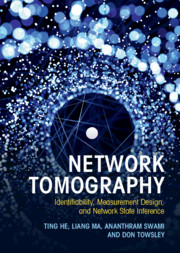Refine search
Actions for selected content:
6791 results in Communications and signal processing
Introduction
-
- Book:
- Network Tomography
- Published online:
- 25 May 2021
- Print publication:
- 27 May 2021, pp 1-2
-
- Chapter
- Export citation
Frontmatter
-
- Book:
- Network Tomography
- Published online:
- 25 May 2021
- Print publication:
- 27 May 2021, pp i-iv
-
- Chapter
- Export citation
5 - Fundamental Conditions for Boolean Network Tomography
-
- Book:
- Network Tomography
- Published online:
- 25 May 2021
- Print publication:
- 27 May 2021, pp 102-137
-
- Chapter
- Export citation
3 - Monitor Placement for Additive Network Tomography
-
- Book:
- Network Tomography
- Published online:
- 25 May 2021
- Print publication:
- 27 May 2021, pp 43-77
-
- Chapter
- Export citation
8 - Stochastic Network Tomography Using Multicast Measurements
-
- Book:
- Network Tomography
- Published online:
- 25 May 2021
- Print publication:
- 27 May 2021, pp 201-217
-
- Chapter
- Export citation
Appendix - Datasets for Evaluations
-
- Book:
- Network Tomography
- Published online:
- 25 May 2021
- Print publication:
- 27 May 2021, pp 226-229
-
- Chapter
- Export citation
Contents
-
- Book:
- Network Tomography
- Published online:
- 25 May 2021
- Print publication:
- 27 May 2021, pp v-viii
-
- Chapter
- Export citation
1 - Preliminaries
-
- Book:
- Network Tomography
- Published online:
- 25 May 2021
- Print publication:
- 27 May 2021, pp 3-9
-
- Chapter
- Export citation
Notation
-
- Book:
- Network Tomography
- Published online:
- 25 May 2021
- Print publication:
- 27 May 2021, pp ix-xii
-
- Chapter
- Export citation
6 - Measurement Design for Boolean Network Tomography
-
- Book:
- Network Tomography
- Published online:
- 25 May 2021
- Print publication:
- 27 May 2021, pp 138-173
-
- Chapter
- Export citation
Index
-
- Book:
- Network Tomography
- Published online:
- 25 May 2021
- Print publication:
- 27 May 2021, pp 230-232
-
- Chapter
- Export citation

Network Tomography
- Identifiability, Measurement Design, and Network State Inference
-
- Published online:
- 25 May 2021
- Print publication:
- 27 May 2021
7 - Cyberattack-Resilient Networked Microgrids
- from Part II - Networked Microgrids
-
- Book:
- Networked Microgrids
- Published online:
- 15 April 2021
- Print publication:
- 06 May 2021, pp 158-179
-
- Chapter
- Export citation
4 - Resilient Networked Microgrids through Software-Defined Networking
- from Part II - Networked Microgrids
-
- Book:
- Networked Microgrids
- Published online:
- 15 April 2021
- Print publication:
- 06 May 2021, pp 43-90
-
- Chapter
- Export citation
1 - Introduction
- from Part I - Fundamentals
-
- Book:
- Networked Microgrids
- Published online:
- 15 April 2021
- Print publication:
- 06 May 2021, pp 3-10
-
- Chapter
- Export citation
Notation
-
- Book:
- Networked Microgrids
- Published online:
- 15 April 2021
- Print publication:
- 06 May 2021, pp xiii-xiv
-
- Chapter
- Export citation
Part III - Prospect
-
- Book:
- Networked Microgrids
- Published online:
- 15 April 2021
- Print publication:
- 06 May 2021, pp 199-200
-
- Chapter
- Export citation
3 - Compositional Networked Microgrid Power Flow
- from Part II - Networked Microgrids
-
- Book:
- Networked Microgrids
- Published online:
- 15 April 2021
- Print publication:
- 06 May 2021, pp 29-42
-
- Chapter
- Export citation
Index
-
- Book:
- Networked Microgrids
- Published online:
- 15 April 2021
- Print publication:
- 06 May 2021, pp 222-228
-
- Chapter
- Export citation
9 - Software-Defined Distribution Network and Software-Defined Microgrids
- from Part III - Prospect
-
- Book:
- Networked Microgrids
- Published online:
- 15 April 2021
- Print publication:
- 06 May 2021, pp 201-214
-
- Chapter
- Export citation
